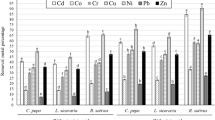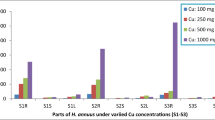Abstract
Contamination levels of copper (Cu) and other heavy metals are very high in the soils of the abandoned copper mine of Lasail in the north western Hajar Mountains of Oman. Environment-friendly approaches such as phytoremediation are needed to clean and rehabilitate these areas to their natural status. In the present study, the phytoremediation potential of castor, Ricinus communis L., was evaluated for copper and other heavy metals by growing it in different types of Cu-mine soils and slags. Growth parameters such as shoot height and biomass weight (fresh and dry) were evaluated. Castor showed a high tolerance index (TI) in Cu-mine soils. The highest TI was calculated for the fresh mass of castor shoots in E soil with a percentage of 405.99. The translocation factor (TF) of all the metals except boron (B) and manganese (Mn) was < 1, which reveals that these metals are stabilised in the root portion of the castor. Bioconcentration factor (BCF) value < 1 for Cu indicates that castor is not a hyperaccumulator plant for copper. In addition to high concentrations of copper, other heavy metals such as arsenic (As), iron (Fe), and zinc (Zn) were observed in the roots than in shoots. Castor grown in slag accumulated Cu in the shoots, roots, and entire plant with the values of 25, 1184, and 1209 mg kg−1, respectively. Similarly, castor cultivated in A soil accumulated 18, 901, and 919 mg kg−1 of copper in shoots, roots, and entire plant, respectively. The calculated plant effective number (PENt) indicated the need for 253 castor plants to remove 1 g of Cu from E soil. The ability of castor to grow well in Cu-mine soils suggests that it can be used for the removal of Cu and other heavy metals. Additionally, the shoot portion could potentially be used for oil production since the phytoaccumulation levels of heavy metal concentration in the shoots were below the standard toxicity limits.




Similar content being viewed by others
References
Andreazza R, Bortolon L, Pieniz S, Camargo FAO (2013) Use of high-yielding bioenergy plant castor bean ( Ricinus communis L.) as a potential phytoremediator for copper-contaminated soils. Pedosph An Int J 23:651–661
Baker AJM (1981) Accumulators and excluders-strategies in the response of plants to heavy metals. J Plant Nutr 3:643–654
Bauddh K, Singh K, Singh B, Singh RP (2015) Ricinus communis: a robust plant for bio-energy and phytoremediation of toxic metals from contaminated soil. Ecol Eng 84:640–652
Bouyoucos GJ (1962) Hydrometer method improved for making particle size analyses of soils 1. Agron J 54:464–465
Burt R (2004) Soil survey laboratory methods manual. Soil survey investigations report 42, version 4.0. United States Department of Agriculture. Nat Resour Conserv Serv Natl Soil Surv Cent
Buscaroli A, Zannoni D, Menichetti M, Dinelli E (2017) Assessment of metal accumulation capacity of Dittrichia viscosa (L.) Greuter in two different Italian mine areas for contaminated soils remediation. J Geochem Explor 182:123–131
Capozzi F, Sorrentino MC, Caporale AG, Fiorentino N, Giordano S, Spagnuolo V (2020). Exploring the phytoremediation potential of Cynara cardunculus: a trial on an industrial soil highly contaminated by heavy metals. 1-10
Cardoso SL, Costa CSD, Nishikawa E, da Silva MGC, Vieira MGA (2017) Biosorption of toxic metals using the alginate extraction residue from the brown algae Sargassum filipendula as a natural ion-exchanger. J Clean Prod 165:491–499
Chakroun HK, Souissi F, Bouchardon JL, Souissi R, Moutte J, Faure O, Remon E, Abdeljaoued S (2010) Transfer and accumulation of lead , zinc , cadmium and copper in plants growing in abandoned mining-district area. Sci Technol 4:651–659
Chiroma TM, Ebewele RO, Hymore FK (2014) Comparative assessement Of heavy metal levels in soil, vegetables and urban grey waste water used for irrigation in Yola and Kano. Int Ref J Eng Sci 3:1–9
Clemens S (2006) Toxic metal accumulation, responses to exposure and mechanisms of tolerance in plants. Biochimie 88:1707–1719
Cluis C (2004) Junk-greedy greens: phytoremediation as a new option for soil decontamination. BioTeach J 2:l–67
de Abreu CA, Coscione AR, Pires AM, Paz-Ferreiro J (2012) Phytoremediation of a soil contaminated by heavy metals and boron using castor oil plants and organic matter amendments. J Geochem Explor 123:3
Diwan H, Khan I, Ahmad A, Iqbal M (2010) Induction of phytochelatins and antioxidant defence system in Brassica juncea and Vigna radiata in response to chromium treatments. Plant Growth Regul 61:97–107
Garcıa G, Faz A, Cunha M (2004) Performance of Piptatherum miliaceum (Smilo grass) in edaphic Pb and Zn phytoremediation over a short growth period. Int Biodeterior Biodegradation 54:245–250
Gaur A, Adholeya A (2004) Prospects of arbuscular mycorrhizal fungi in phytoremediation of heavy metal contaminated soils. Curr Sci 86:528–534
Gonzalez-Chavez MCA, Olivares AR, Carrillo-Gonzalez R, Leal ER (2015) Crude oil and bioproducts of castor bean (Ricinus communis L.) plants established naturally on metal mine tailings. Int J Environ Sci Technol 12:2263–2272
Groninger J, Skousen J, Angel P, Barton C, Burger J, Zipper C (2007) Mine reclamation practices to enhance forest development through natural succession. In: Adams MB (ed) The Forestry Reclamation Approach: guide to successful reforestation of mined lands. Gen. Tech. Rep. NRS-169, vol 8-1–8-7. US Department of Agriculture, Forest Service, Northern Research Station, Newtown Square, PA, pp 1–7
Hinchman RR, Negri MC, Gatliff EG (1995) Phytoremediation: using green plants to clean up contaminated soil, groundwater, and waste-water ray. Applied Natural Sciences, Inc
Huang G, Rizwan MS, Ren C, Guo G, Fu Q, Zhu J, Hu H (2018) Influence of phosphorous fertilization on copper phytoextraction and antioxidant defenses in castor bean (Ricinus communis L.). Environ Sci Pollut Res 25:115–123
Huang H, Yu N, Wang L, Gupta DK, He Z, Wang K, Zhu Z, Yan X, Li T, Yang XE (2011) Bioresource Technology The phytoremediation potential of bioenergy crop Ricinus communis for DDTs and cadmium co-contaminated soil. Bioresour Technol 102:11034–11038
Kiran BR, Prasad MNV (2017) Ricinus communis L. (Castor bean), a potential multi-purpose environmental crop for improved and integrated phytoremediation. Euro Biotech J 1:101–116
Kohl KI, Losch R (1999) Experimental characterization of heavy metal tolerance in plants. In: Heavy metal stress in plants. Springer, Berlin, pp 371–389
Jacob JM, Karthik C, Saratale RG, Kumar SS, Prabakar D, Kadirvelu K, Pugazhendhi A (2018) Biological approaches to tackle heavy metal pollution: a survey of literature. J Environ Manag 217:56–70
Lago-Vila M, Arenas-Lago D, Andrade L, Vega FA (2014) Phytoavailable content of metals in soils from copper mine tailings. J Geochem Explor 147:159–166
Lee J (2016) Characterization of heavy metal tolerance and accumulation in Indian mustard overexpressing bacterial γ-ECS gene
Mahmud R, Inoue N, Kasajima S, Shaheen R (2008) Assessment of potential indigenous plant species for the phytoremediation of arsenic-contaminated areas of Bangladesh. Int J Phytoremediation 10:119–132
Martinez-Saznchez MJ, Garcia-Lorenzo ML, Perez-Sirvent C, Bech J (2012) Trace element accumulation in plants from an aridic area affected by mining activities. J Geochem Explor 123:8–12
Melo EEC, Costa ETS, Guilherme LRG, Faquin V, Nacimento CWA (2009) Accumulation of arsenic and nutrients by castor bean plants grown on an As-enriched nutrient solution. J Hazard Mater 168:479–483
Mertens J, Luyssaert S, Verheyen K (2005) Use and abuse of trace metal concentrations in plant tissue for biomonitoring and phytoextraction. Environ Pollut 138:1–4
Mo C-H, Cai Q-Y, Li H-Q, Zeng Q-Y, Tang S-R, Zhao Y-C (2008) Potential of different species for use in removal of DDT from the contaminated soils. Chemosphere 73:120–125
Nawrot N, Wojciechowska E, Matej-Łukowicz K, Walkusz-Miotk J, Pazdro K (2019) Heavy metal accumulation and distribution in Phragmites australis seedlings tissues originating from natural and urban catchment. Environ Sci Pollut Res:1–11
Nirola R, Megharaj M, Aryal R, Naidu R (2016) Screening of metal uptake by plant colonizers growing on abandoned copper mine in Kapunda, South Australia. Int J Phytoremediation 18:399–405
Olivares AR, Carrillo-gonzalez R, Gonzalez-chavez MDCA, Hernandez RMS (2013) Potential of castor bean ( Ricinus communis L .) for phytoremediation of mine tailings and oil production. J Environ Manag 114:316–323
Palanivel TM, Victor R (2019) Contamination assessment of heavy metals in the soils of an abandoned copper mine in Lasail, Northern Oman. Int J Environ Stud 00:1–15
Pandey VC (2013) Suitability of Ricinus communis L. cultivation for phytoremediation of fly ash disposal sites. Ecol Eng 57:336–341
Pandey VC (2012) Invasive species based efficient green technology for phytoremediation of fly ash deposits. J Geochem Explor 123:13–18
Partington G (2010) Developing models using GIS to assess geological and economic risk: an example from VMS copper gold mineral exploration in Oman. Ore Geol Rev 38:197–207
Peralta-Videa JR, Gardea-Torresdey JL, Gomez E, Tiemann KJ, Parsons JG, Carrillo G (2002) Effect of mixed cadmium, copper, nickel and zinc at different pHs upon alfalfa growth and heavy metal uptake. Environ Pollut 119:291–301
Pratas J, Prasad MNV, Freitas H, Conde L (2005) Plants growing in abandoned mines of Portugal are useful for biogeochemical exploration of arsenic, antimony, tungsten and mine reclamation. J Geochem Explor 85:99–107
Rahman MA, Hasegawa H (2011) Aquatic arsenic: phytoremediation using floating macrophytes. Chemosphere 83:633–646
Rajkumar M, Freitas H (2008) Influence of metal resistant-plant growth-promoting bacteria on the growth of Ricinus communis in soil contaminated with heavy metals. Chemosphere 71:834–842
Rascio N, Navari-Izzo F (2011) Heavy metal hyperaccumulating plants: how and why do they do it? And what makes them so interesting? Plant Sci 180:169–181
Salt D, Lindenmayer D (2008) Is revegetation good for biodiversity? Land and Water Australia
Shanker AK, Ravichandran V, Pathmanabhan G (2005) Phytoaccumulation of chromium by some multipurpose-tree seedlings. Agrofor Syst 64:83–87
Stoltz E, Greger M (2002) Accumulation properties of As, Cd, Cu, Pb and Zn by four wetland plant species growing on submerged mine tailings. Environ Exp Bot 47:271–280
Sun Y, Zhou Q, Diao C (2008) Effects of cadmium and arsenic on growth and metal accumulation of Cd-hyperaccumulator Solanum nigrum L. Bioresour Technol 99:1103–1110
Tapia Y, Bustos P, Salazar O, Casanova M, Castillo B, Acuna E, Masaguer A (2017) Phytostabilization of Cu in mine tailings using native plant Carpobrotus aequilaterus and the addition of potassium humates. J Geochem Explor 183:102–113
Thakur S, Singh L, Ab Wahid Z et al (2016) Plant-driven removal of heavy metals from soil: uptake, translocation, tolerance mechanism, challenges, and future perspectives. Environ Monit Assess 188:206
Vamerali T, Bandiera M, Mosca G (2010) Field crops for phytoremediation of metal-contaminated land. A review. Environ Chem Lett 8:1–17
Walkley A, Black IA (1934) An examination of the Degtjareff method for determining soil organic matter, and a proposed modification of the chromic acid titration method. Soil Sci 37:29–38
Wanner P, Al-Sulaimani MYN, Waber N, Wanner C (2015) Assessing the environmental hazard of using seawater for ore processing at the Lasail mine site in the Sultanate of Oman. Mine Water Environ 34:59–74
Wenzel WW (2009) Rhizosphere processes and management in plant-assisted bioremediation (phytoremediation) of soils. Plant Soil 321:385–408
Wuana RA, Okieimen FE (2011) Heavy metals in contaminated soils: a review of sources, chemistry, risks and best available strategies for remediation. Isrn Ecol 2011:20
Zacchini M, Pietrini F, Mugnozza GS, Lori V, Pietrosanti L, Massacci A (2009) Metal tolerance, accumulation and translocation in poplar and willow clones treated with cadmium in hydroponics. Water Air Soil Pollut 197:23–34
Acknowledgments
We wish to acknowledge Mr. Abdulla Al Shriqi, Head, Life Science Unit, Sultan Qaboos University, for providing the space to cultivate the castor plants during the study period. The Department of Biology, College of Science, Sultan Qaboos University, is acknowledged for partially supporting this project.
Author information
Authors and Affiliations
Corresponding author
Ethics declarations
Conflict of interest
The authors declare that they have no conflicts of interest.
Additional information
Responsible Editor: Elena Maestri
Publisher’s note
Springer Nature remains neutral with regard to jurisdictional claims in published maps and institutional affiliations.
Rights and permissions
About this article
Cite this article
Palanivel, T.M., Pracejus, B. & Victor, R. Phytoremediation potential of castor (Ricinus communis L.) in the soils of the abandoned copper mine in Northern Oman: implications for arid regions. Environ Sci Pollut Res 27, 17359–17369 (2020). https://doi.org/10.1007/s11356-020-08319-w
Received:
Accepted:
Published:
Issue Date:
DOI: https://doi.org/10.1007/s11356-020-08319-w




